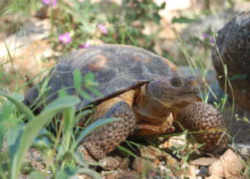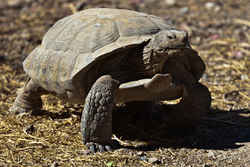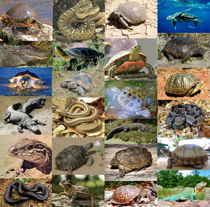
California Symbols
California State Reptile
Desert Tortoise
(Gopherus agassizi)
Adopted in 1972
Under a full head of steam, the desert tortoise, (Gopherus agassizi,) moves at a stolid pace of about 20 feet per minute. This patient vegetarian has existed on Earth almost unchanged for millions of years. It is found in the southwestern desert areas of California where it now enjoys protected status as an endangered species.
The desert tortoise played a key role in the passage of the California Desert Protection Act in 1994. To protect the fragile desert habitat of the tortoise and other plants and animals, millions of acres were added to the national park and wilderness system. Supporters reportedly brought a desert tortoise to the White House for the bill signing. The tortoise has been the official State Reptile since 1972.
California State Reptile: Desert Tortoise
 Desert Tortoise, the largest reptile in the Southwestern United States, lives in the extreme southern parts of Nevada. Its hard, dome-shaped shell ranges from tan to black in color. This reptile spends much of its life in underground burrows to escape the harsh summer heat and winter cold. The desert tortoise can live to be more than 70 years old.
Desert Tortoise, the largest reptile in the Southwestern United States, lives in the extreme southern parts of Nevada. Its hard, dome-shaped shell ranges from tan to black in color. This reptile spends much of its life in underground burrows to escape the harsh summer heat and winter cold. The desert tortoise can live to be more than 70 years old.
Tortoises may be distinguished from other turtle families by the following characteristics: the hind legs are cylindrical and elephantine in shape: the feet are short, broad and club-shaped. In some genera, the forelimbs are flattened and adapted for digging and burrowing and the toes are not webbed. The carapace (upper shell) is usually high and domed with the ribs modified in alternating triangular wedges. All are terrestrial and basically herbivorous, although they may occasionally eat invertebrates and carrion.
The desert tortoise, an ancient denizen of western North America, occurs today in the Mohave and Sonoran deserts in southwestern Utah, southern Nevada, southeastern California and western Arizona in the United States. It is the state reptile of both Nevada and California and has been listed under the Federal Endangered Species Act since 1989. It is also the largest reptile found in the Mojave desert.
The desert tortoise has a life span of 70-100 years. They normally weigh between 8-15 pounds, have a shell 9-15 inches in length, are 4-6 inches tall and eat herbs, grasses, wildflowers and some shrubs and cacti. They sexually mature in 14-20 years and produce eggs in May-July.
Very few of every hundred hatchlings reach maturity. Ravens take a greatest toll of the juvenile (about 2-3 inches long) tortoise population, while the shells are still soft.
Roadrunners, Gila Monsters and Coyotes also prey on the juveniles of the Mojave. Humans are responsible for killing many tortoises, intentionally by shooting them and capturing them, unintentionally by running over them with vehicles on the road and with off-road vehicles in the desert.
California Government Code, Title 1, Division 2, Chapter 2.
CALIFORNIA GOVERNMENT CODE
TITLE 1. GENERAL
DIVISION 2. STATE SEAL, FLAG, AND EMBLEMS
CHAPTER 2. STATE FLAG AND EMBLEMS
SECTION 420-429.8
422.5. The California desert tortoise (gopherus agassizii) is the official state reptile.
Taxonomic Hierarchy of the Desert Tortoise |
|
|---|---|
| Kingdom: | Animalia |
| Phylum: | Chordata |
| Clade: | Sauropsida |
| Order: | Testudines (=Chelonii) |
| Suborder: | Cryptodira |
| Superfamily | Testudinoidea |
| Family: | Testudinidae |
| Genus: | Gopherus Rafinesque, 1832 |
| Species: | Gopherus agassizi |







